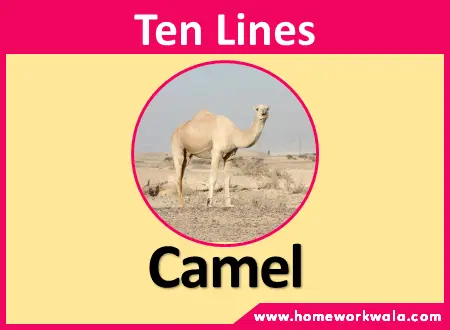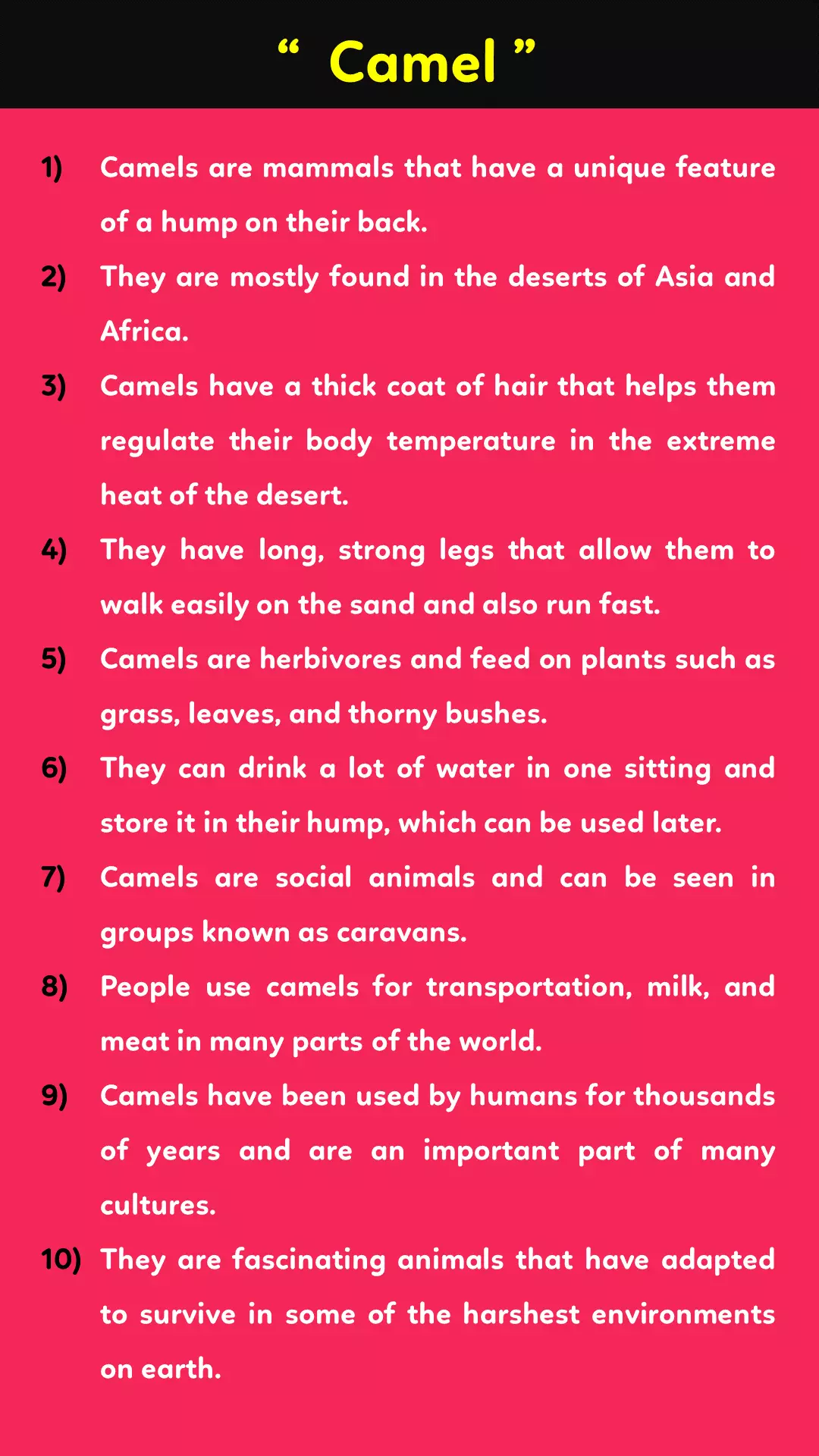Table of Content
Through this article, we are sharing 10 lines on Camel in English. This post will help those students who are looking for information about Camel in the English Language.
If any student wants to write a short essay on Camel then, this post is very useful for them. Information about Camel is very simple and easy for writing purposes.
These sentences on Camel are very short and easy to understand, so any level of student can write on this topic.

Short essay on Camel in English ( In 3 Formats )
Format-1
- Camels are mammals that have a unique feature of a hump on their back.
- They are mostly found in the deserts of Asia and Africa.
- Camels have a thick coat of hair that helps them regulate their body temperature in the extreme heat of the desert.
- They have long, strong legs that allow them to walk easily on the sand and also run fast.
- Camels are herbivores and feed on plants such as grass, leaves, and thorny bushes.
- They can drink a lot of water in one sitting and store it in their hump, which can be used later.
- Camels are social animals and can be seen in groups known as caravans.
- People use camels for transportation, milk, and meat in many parts of the world.
- Camels have been used by humans for thousands of years and are an important part of many cultures.
- They are fascinating animals that have adapted to survive in some of the harshest environments on earth.
You May Also Like
Format-2
- Camels have long eyelashes that protect their eyes from the blowing sand and dust of the desert.
- They have a strong sense of smell and can detect water from far away.
- Camels have a split upper lip that allows them to eat thorny plants without hurting their mouth.
- They have a unique ability to go for long periods without water, sometimes up to several weeks.
- Camels can carry heavy loads of up to 600 pounds on their back.
- They are known for their distinctive grunting, growling, and hissing sounds.
- Camels have been domesticated for thousands of years and are an important part of the economy in many countries.
- There are two types of camels: dromedary camels have one hump, while Bactrian camels have two humps.
- The hump of a camel is not filled with water, but with fat that provides energy when food and water are scarce.
- Camels are well-suited for life in the desert and are an important part of the ecosystem in their native habitat.
Format-3
- Camels are strong and hardy animals that can survive in harsh desert environments.
- They have thickly padded feet that help them walk on hot sand without burning their skin.
- Camels are social animals and communicate with each other through a range of vocalizations, body language, and scent marking.
- Their long, curved necks allow them to reach high branches and leave that other animal cannot reach.
- Camels have a keen sense of hearing that helps them detect danger from far away.
- They have a lifespan of around 40 to 50 years and can continue working well into their old age.
- Camels can sleep while standing up, which helps them avoid predators in the wild.
- They are known for their ability to spit, which they use as a defense mechanism when threatened or agitated.
- Camels have a gentle and calm temperament and are often used for therapy and interaction with humans.
- They are fascinating animals that have played an important role in the history and culture of many countries around the world.

FAQ
- What are camels?
- Where do camels live?
- What do camels eat?
- What are the different types of camels?
- What are camels used for?
- Are camels dangerous?
- Can camels run fast?
- How long do camels live?
- What is the importance of camels in different cultures?
Camels are large, sturdy mammals that are well-adapted to life in desert regions. They are known for their distinctive humps and long, curved necks.
Camels are found in various parts of the world, including the deserts of Africa, the Middle East, and parts of Asia. Some species of camels are also found in other regions, such as Australia.
Camels are herbivores and mainly feed on vegetation such as grasses, leaves, and thorny plants. They have a specialized digestive system that allows them to extract maximum nutrition from the tough desert plants they consume.
There are two main types of camels: dromedary camels, which have one hump, and Bactrian camels, which have two humps. They are distinct species that have adapted to different regions and climates.
Camels have been used by humans for transportation, food, and milk for thousands of years. They are also used in many parts of the world for racing, as well as in the tourism and entertainment industries.
Camels are generally gentle and calm animals, but they can become aggressive if provoked or threatened. They are large, powerful animals, and it is important to respect their space and not approach them too closely.
Yes, camels are surprisingly fast runners and can reach speeds of up to 40 miles per hour. They are also able to run for long distances without getting tired, making them well-suited for desert travel.
Camels have a lifespan of around 40 to 50 years and can continue working well into their old age.
Camels have played an important role in the history and culture of many countries around the world. They are often associated with desert regions and are a symbol of resilience and endurance. In many cultures, they are also seen as a source of wealth and prestige.
We hope! You will get some learning through this article. If you really like this article about Camel in English, then please share it with your friends.
We working on helping the students to do their homework in a simple and easy way. Essay writing on Camel is generally asked the students in Schools.